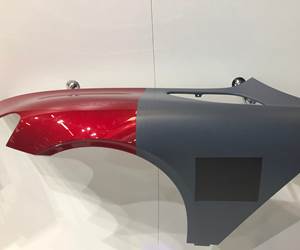PlastiComp introduces carbon-glass hybrid LFT
The new hybrid composite pellet products combine long glass fiber and long carbon fiber together, bridging the performance gap between either fiber used alone.
PlastiComp, Inc. (Winona, Minn., USA), a supplier of long fiber thermoplastic (LFT) materials and technologies, has developed an innovative set of hybrid thermoplastic composites that combine long glass fiber and long carbon fiber reinforcement together in a single, ready-to-mold composite pellet. The new products expand the performance range of long fiber material options available to product designers while offering a cost effective avenue to adopt the high performance capabilities of carbon fiber.
“PlastiComp’s new hybrid long glass+carbon fiber reinforced products really hit a sweet spot that nicely bridge the performance gap between using either of these fibers by themselves,” said Eric Wollan, business development manager at PlastiComp. “The carbon fiber significantly boosts strength and stiffness while the glass fiber allows the toughness that many choose LFT materials for to be retained. Strength and toughness are key long fiber attributes that can’t be achieved in unison with other reinforcement methods.”
A nylon 6/6 hybrid 40 percent long glass+carbon fiber reinforced composite with 20 percent carbon fiber and 20 percent glass fiber has a tensile strength of 41,200 psi (284 MPa), which is 96 percent that of an equivalently loaded long carbon fiber material and 24 percent higher than a similar long glass fiber material. It possesses a flexural modulus of 2,600 ksi (17,931 MPa), which is 87 percent that of carbon and 86 percent higher than glass. The inclusion of long glass fiber allows the material to retain 78 percent of the un-notched impact capability of glass at 18.8 ft·lb/in (1,004 J/m), which is a 25 percent improvement over carbon alone.
“There is an interesting synergy taking place in these hybrid long glass+carbon fiber composites,” said Wollan. “We can reduce the amount of carbon fiber used by half and still keep 85-95 percent of the strength and stiffness, plus the addition of glass fiber is bumping up the durability by up to 25 percent. That performance combination really makes these products attractive, because they land right where a lot of people need to be to use LFT composites as substitutes for metals.”
“Although long carbon fiber reinforced composites are the pinnacle of thermoplastic performance, economically their use can’t be justified in a lot of applications,” says Wollan. “Now, with these new hybrid long glass+carbon fiber composites, PlastiComp has a stepping stone material in the middle of the glass fiber to carbon fiber gap that can be 20-50 percent less expensive with hardly any performance hit.”
PlastiComp can customize the percentage combinations of glass and carbon fiber in these hybrid LFT materials to tailor performance and cost to meet individual application specifications across any market segment. They are especially advantageous to consumer and sporting goods products where the inclusion of carbon fiber allows them to be marketed as utilizing high performance composites and obtain a price premium. The cost/benefit ratio of these composites should be attractive to the automotive and transportation industries that are aggressively trying to reduce weight for improved fuel economy and lower emissions. They are strong contenders for under-the-hood components that require elevated temperature and load bearing capabilities.
PlastiComp manufactures its trademarked LFT Complēt composite pellets using an optimized pultrusion process that maximizes resin and fiber bonding to obtain the highest possible mechanical properties. Hybrid long glass+carbon and other LFT composites from PlastiComp are made-to-order in polymers from polypropylene to PEEK.
As a vertical, full-service long fiber compounder, PlastiComp can provide design and analysis services when converting applications to new materials as well as partnering with OEMs on new product development programs to customize LFT materials and processes to meet specific performance criteria.
Related Content
Welding is not bonding
Discussion of the issues in our understanding of thermoplastic composite welded structures and certification of the latest materials and welding technologies for future airframes.
Read MoreThe potential for thermoplastic composite nacelles
Collins Aerospace draws on global team, decades of experience to demonstrate large, curved AFP and welded structures for the next generation of aircraft.
Read MoreThe state of recycled carbon fiber
As the need for carbon fiber rises, can recycling fill the gap?
Read MorePEEK vs. PEKK vs. PAEK and continuous compression molding
Suppliers of thermoplastics and carbon fiber chime in regarding PEEK vs. PEKK, and now PAEK, as well as in-situ consolidation — the supply chain for thermoplastic tape composites continues to evolve.
Read MoreRead Next
Modeling and characterization of crushable composite structures
How the predictive tool “CZone” is applied to simulate the axial crushing response of composites, providing valuable insights into their use for motorsport applications.
Read More“Structured air” TPS safeguards composite structures
Powered by an 85% air/15% pure polyimide aerogel, Blueshift’s novel material system protects structures during transient thermal events from -200°C to beyond 2400°C for rockets, battery boxes and more.
Read MorePlant tour: A&P, Cincinnati, OH
A&P has made a name for itself as a braider, but the depth and breadth of its technical aptitude comes into sharp focus with a peek behind usually closed doors.
Read More










.jpg;maxWidth=300;quality=90)














